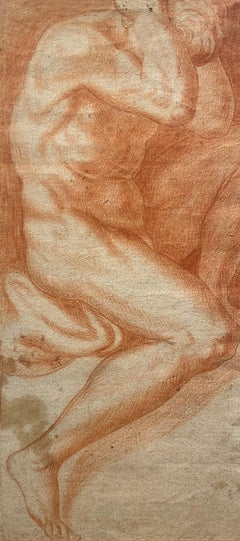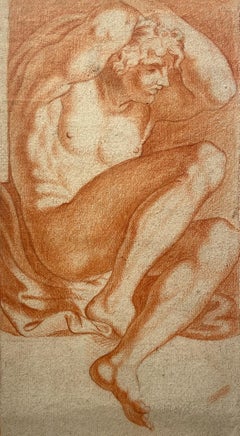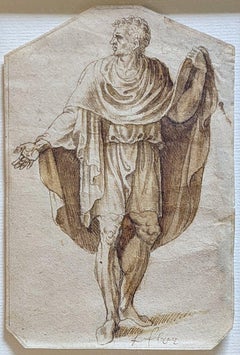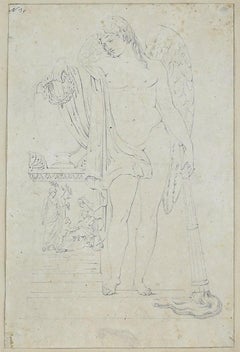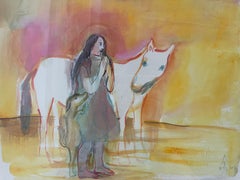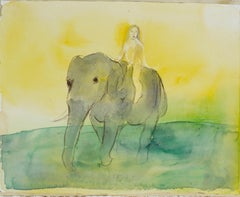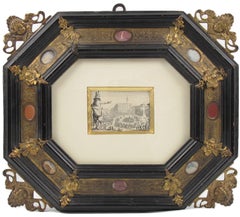Renaissance Drawings and Watercolor Paintings
to
1
5
2
3
5
5
Overall Height
to
Overall Width
to
138
33
1
1
5
3
3
3
2
2
1
1
1
5
3
82
2
77
2
2
3
2
1
1
1
Style: Renaissance
Period: 18th Century and Earlier
Jacopo Zanguidi Dit Bertoja (1544 - 1574) - Important 16th Century Drawing
Located in PARIS, FR
Jacopo Zanguidi BERTOJA (1544-1574)
Combat of five figures, bas-relief from the School of Athens after Raphael
Ink on paper
43×34cm
Interesting thing
According to Professor David E...
Category
16th Century Renaissance Drawings and Watercolor Paintings
Materials
Ink
The Captive, Study of a Naked Man, Red Chalk Study, Carracci Gallery
By Annibale Carracci
Located in London, GB
Red chalk on paper
Image size: 11 x 5 1/2 inches (28 x 14 cm)
Mounted
This 18th century drawing is after the work of the 16th Century Italian artist Annibale Carraci. This figure, along with many more, were painted by Carraci in the Palazzo Farnese in a space now known as the Carracci gallery. The Carracci gallery is considered as one of the most important Renaissance commissions in Rome. This figure, along with five other companions, were known as 'The Captives'. They were designed by the artist to appear trapped in the architectural spaces in the walls and sat around the fresco that featured Perseus and Andromeda.
Annibale Carracci
Annibale Carracci (1560–1609) was the most admired painter of his time and the vital force in the creation of Baroque style. Together with his cousin Ludovico (1555–1619) and his older brother Agostino (1557–1602)—each an outstanding artist—Annibale set out to transform Italian painting. The Carracci rejected the artificiality of Mannerist painting, championing a return to nature coupled with the study of the great northern Italian painters of the Renaissance, especially Correggio, Titian, and Veronese.During the 1580s, the Carracci were painting the most radical and innovative pictures in Europe. Annibale not only drew from nature, he created a new, broken brushwork to capture movement and the effects of light on form. His Two Children Teasing a Cat marks a new chapter in the history of genre painting.
The revolutionary potential of this new kind of painting would be taken up over a decade later by Caravaggio, who must have seen the Carraccis’ work while traveling from Milan to Rome in 1592.The Carracci saw themselves as heir to a great artistic tradition, and they consciously situated themselves within the history of northern Italian painting. Annibale and Agostino visited Parma and Venice to study the work of Correggio, Titian, Tintoretto, and Veronese. Their altarpieces and secular fresco cycles in Bologna reasserted a northern Italian emphasis on color, light, and the study of nature, but with a new focus on emotive communication. Their success led to Annibale being invited to Rome to work for the powerful Farnese family (1595). Ludovico remained in Bologna to direct the academy they founded. Through the next generation of painters—Francesco Albani, Domenichino, Guido Reni, Giovanni Lanfranco, and Guercino—Bolognese painting became the dominant force in seventeenth-century art.
In Rome, Annibale’s painting was transformed through his first-hand encounter with classical antiquity and the art of Michelangelo and Raphael. Individual scenes of ancient mythology are surrounded by an elaborate illusionistic framework with feigned statues, in front of which sit muscular nude figures seemingly lit from the actual windows (Galleria Farnese ceiling). The corners are opened to painted views of the sky. When unveiled in 1600, the ceiling was instantly acclaimed as the equal of any work in the past. In combining northern Italian naturalism with the idealism of Roman painting, Annibale created the basis of Baroque art. His only challenger in Rome was Caravaggio, whose relation with the past was combative rather than assimilative. Moreover, Caravaggio’s art...
Category
18th Century Renaissance Drawings and Watercolor Paintings
Materials
Chalk, Paper
The Captive, Study of a Naked Youth, Red Chalk Study, Carracci Gallery
By Annibale Carracci
Located in London, GB
Red chalk on paper
Image size: 5 x 8 1/2 inches (12.75 x 21.5 cm)
Mounted
This 18th century drawing is after the work of the 16th Century Italian artist Annibale Carraci. This figure, along with many more, were painted by Carraci in the Palazzo Farnese in a space now known as the Carracci gallery. The Carracci gallery is considered as one of the most important Renaissance commissions in Rome. This figure, along with five other companions, were known as 'The Captives'. They were designed by the artist to appear trapped in the architectural spaces in the walls and sat around the fresco that featured Perseus and Andromeda.
Similarly to the original drawings, this artist has taken considerable care to sculpt his form with light and shadow, gently blending strokes on the smooth-skinned cheek and distinctly denoting the direction of hair strands.
Annibale Carracci
Annibale Carracci (1560–1609) was the most admired painter of his time and the vital force in the creation of Baroque style. Together with his cousin Ludovico (1555–1619) and his older brother Agostino (1557–1602)—each an outstanding artist—Annibale set out to transform Italian painting. The Carracci rejected the artificiality of Mannerist painting, championing a return to nature coupled with the study of the great northern Italian painters of the Renaissance, especially Correggio, Titian, and Veronese.
During the 1580s, the Carracci were painting the most radical and innovative pictures in Europe. Annibale not only drew from nature, he created a new, broken brushwork to capture movement and the effects of light on form. His Two Children Teasing a Cat marks a new chapter in the history of genre painting. The revolutionary potential of this new kind of painting would be taken up over a decade later by Caravaggio, who must have seen the Carraccis’ work while traveling from Milan to Rome in 1592.
The Carracci saw themselves as heir to a great artistic tradition, and they consciously situated themselves within the history of northern Italian painting. Annibale and Agostino visited Parma and Venice to study the work of Correggio, Titian, Tintoretto, and Veronese. Their altarpieces and secular fresco cycles in Bologna reasserted a northern Italian emphasis on color, light, and the study of nature, but with a new focus on emotive communication. Their success led to Annibale being invited to Rome to work for the powerful Farnese family (1595). Ludovico remained in Bologna to direct the academy they founded. Through the next generation of painters—Francesco Albani, Domenichino, Guido Reni, Giovanni Lanfranco, and Guercino—Bolognese painting became the dominant force in seventeenth-century art.
In Rome, Annibale’s painting was transformed through his first-hand encounter with classical antiquity and the art of Michelangelo and Raphael. Individual scenes of ancient mythology are surrounded by an elaborate illusionistic framework with feigned statues, in front of which sit muscular nude figures seemingly lit from the actual windows (Galleria Farnese ceiling). The corners are opened to painted views of the sky. When unveiled in 1600, the ceiling was instantly acclaimed as the equal of any work in the past. In combining northern Italian naturalism with the idealism of Roman painting, Annibale created the basis of Baroque art. His only challenger in Rome was Caravaggio, whose relation with the past was combative rather than assimilative. Moreover, Caravaggio’s art...
Category
18th Century Renaissance Drawings and Watercolor Paintings
Materials
Chalk, Paper
Study of a Man, Old Master Drawing, Figure, Roman Study, Lombard
Located in Greven, DE
Old Master Drawing by the Circle of Lambert Lombard. Drawing/ Study of a Man in Renaissance Style, later signed "F. Floris".
Study of a Man
Lombard li...
Category
16th Century Renaissance Drawings and Watercolor Paintings
Materials
Handmade Paper
Study for Statue - Pencil Drawing by Giovanni Fontana - Early 17th Century
Located in Roma, IT
Study for Statue is an original drawing in pencil on paper, realized by the architect and engineer Giovanni Fontana (1540-1614).
The state of preservation of the artwork is good exc...
Category
Early 17th Century Renaissance Drawings and Watercolor Paintings
Materials
Pencil
Related Items
Expressionist Figurative water color painting- Series The Horse Whisper No.2-25
Located in Beijing, CN
Expressionist Figurative water color painting by Zhang Chunyang
Series The Horse Whisper No.2-25
Dimension: 29 x 36 cm
Material: Gouache, Watercolor on Paper
Date: 2013
Artist B...
Category
2010s Renaissance Drawings and Watercolor Paintings
Materials
Watercolor, Gouache, Handmade Paper
Zhang ChunyangExpressionist Figurative water color painting- Series The Horse Whisper No.2-25 , 2013
Free Shipping
H 11.42 in W 14.18 in
Expressionist Figurative water color painting- Luckiness
Located in Beijing, CN
Expressionist Figurative water color painting by Zhang Chunyang
Title: Luckiness
Dimension: 29 x 36 cm
Material: Gouache, Watercolor on Paper
D...
Category
2010s Renaissance Drawings and Watercolor Paintings
Materials
Watercolor, Gouache, Handmade Paper
Free Shipping
H 11.42 in W 14.18 in
19th Century Italian Miniature Painting The Madonna & Child, Signed original
By J. Canava
Located in Cirencester, Gloucestershire
The Madonna & Child
by J. Canava, Italian late 19th century
miniature painting on ceramic, framed within velvet inset and frame
image measures 3.2...
Category
Late 19th Century Renaissance Drawings and Watercolor Paintings
Materials
Gouache
H 5.5 in W 2.5 in D 0.5 in
19th Century Italian Miniature Painting The Madonna & Child, Signed original
By J. Canava
Located in Cirencester, Gloucestershire
The Madonna & Child
by J. Canava, Italian late 19th century
miniature painting on ceramic, framed within velvet inset and frame
image measures 3.2...
Category
Late 19th Century Renaissance Drawings and Watercolor Paintings
Materials
Gouache
H 5.5 in W 2.5 in D 0.5 in
The Dancers, French Late Mid Century Gouache on Textured Paper
Located in Cotignac, FR
Late Mid Century French watercolour and Gouache on handmade paper of a pair of dancers by Damien Hermellin. Signed and dated bottom right. Pres...
Category
1970s Renaissance Drawings and Watercolor Paintings
Materials
Paper, Watercolor, Gouache, Handmade Paper
H 18 in W 15.5 in D 1.5 in
Freya (Seated Backwards), Mixed media on grey board
Located in London, GB
Howard Tangye (b.1948, Australia) has been an influential force in fashion for decades. Lecturing at London’s Central Saint Martins for 35 years, including 16 years as head of BA Wom...
Category
2010s Renaissance Drawings and Watercolor Paintings
Materials
Other Medium, Archival Paper, Handmade Paper, Pen, Felt Pen, Permanent M...
A red chalk study sheet by Baldassare Franceschini, known as Volterrano
Located in PARIS, FR
This fresh sanguine sheet presents various studies placed next to each other in no apparent order. Two of the feet studies are preparatory to the first major commission received by the young Baldassare Franceschini, shortly after his installation in Florence, the frescoes for the Medici Fastes. This cycle was executed between 1636 and 1646 for the Villa La Petraia, a Medici villa on the outskirts of Florence, which allows us to date this sheet to the artist's youth.
1. The Medici Fastes, the first major commission for a young artist
Born in Volterra in 1611, the town from which he took his nickname, Baldassare Franceschini apprenticed with his father, a sculptor of alabaster, one of his home town's specialities, and studied with Cosimo Daddi (1540-1630), a local artist. The Marquis Inghirami, who spotted his talent, sent him to the workshop of Matteo Rosselli (1578 - 1650) in Florence, which was also attended by Francesco Furini (1603 - 1646).
In 1636, Lorenzo de' Medici, the youngest son of Ferdinand Ier and Christine of Lorraine, chose the 25-year-old artist, again on the advice of the Marquis Inghirami, to decorate with frescoes the loggias of the inner courtyard of the Villa La Petraia, which he had just inherited on the death of his mother. The project lasted about ten years and included ten scenes placed symmetrically in two loggias on either side of the courtyard: four main scenes and six placed above the doors, each to the glory of a member of the Medici family.
This decoration was his major secular project, but Volterrano also executed several religious frescoes and a few easel paintings, often with less success. Among the religious commissions, we can cite the dome of the Colloredo chapel dedicated to Saint Lucy...
Category
Mid-17th Century Renaissance Drawings and Watercolor Paintings
Materials
Chalk, Paper
Untitled (Renaissance Male Nude Figure Study), 1963, Ian Hornak — Drawing
By Ian Hornak
Located in Auburn Hills, MI
Original drawing on archival paper, circa 1963. Paper Size: 18 x 23 inches. Provenance: Estate of Ian Hornak, East Hampton, New York. Notes: Created during Hornak’s undergraduate st...
Category
1960s Renaissance Drawings and Watercolor Paintings
Materials
Charcoal, Archival Paper
No Reserve
H 18 in W 23 in
The Adoration Of The Christ Child Fine Renaissance Old Master Painting Large
Located in Cirencester, Gloucestershire
Artist/School: After Filippo Lippi, Italian 1406-1469. The work is most likely by an English hand, late 19th century
Title: The Adoration of the Christ ...
Category
19th Century Renaissance Drawings and Watercolor Paintings
Materials
Watercolor
Wedding Procession - Raised Line Woodcut Hand Painted 1924 Betha Lum
By Bertha Boynton Lum
Located in Soquel, CA
Wedding Procession is a colored raised line woodcut, done in 1924 by Bertha Boynton Lum (American, 1869 – 1954) . The image measures 13-7/8 x 10-1/8". Raised line impression and painted by the artist, while living in China.
Image 13.25"H x 8.75"W
Sheet 14.75"H x 10.75" (approx)
Signed Lower center in pencil "Bertha Lum"
New acid free mat included.
Bertha Lum was fascinated by the legends and mythology of the Orient and wrote extensively about them. These legends provided the subject matter for many of her works in woodcut.
Bertha Boynton Lum was an American artist known for helping popularize the Japanese and Chinese woodblock print outside of Asia.
In May 1869, Lum was born as Bertha Boynton Bull in Tipton, Iowa. Lum's father was Joseph W. Bull (1841–1923), a lawyer and her mother was Harriet Ann Boynton (1842–1925), a school teacher. Both of Lum's parents were amateur artists. Lum had a sister and two brothers, Clara, Carlton, and Emerson.
Education and career:
In 1890 she lived in Duluth and listed her occupation as artist. She enrolled in the design department of the Art Institute of Chicago in 1895. A few years later she studied stained glass with Anne Weston and attended the Frank Holme School of Illustration.
From November 1901 to March 1902, she studied figure drawing at the Art Institute of Chicago and was influenced by the Japanese techniques of Arthur Wesley Dow in his book Composition, which was published in 1899.
Lum married Burt F. Lum, a corporate lawyer from Minneapolis, Minnesota, in 1903. They spent their seven-week honeymoon in Japan, where she searched for a print maker who could teach her the traditional ukiyo-e method. Toward the end of her stay in Japan, she found a shop that reproduced old prints. The shop sold her some woodcutting tools...
Category
1920s Renaissance Drawings and Watercolor Paintings
Materials
Rice Paper, Gouache
H 21 in W 15.75 in D 0.38 in
Surrealist Gouache and Watercolour on Paper, 'Sunday School Ghosts'.
Located in Cotignac, FR
Surrealist watercolour and gouache on handmade paper by British artist Derek Carruthers. Signed bottom right and signed, dated and titled 'Sunday School Ghosts' to the reverse.
A wo...
Category
21st Century and Contemporary Renaissance Drawings and Watercolor Paintings
Materials
Acrylic, Gouache, Watercolor, Handmade Paper
H 22.45 in W 29.93 in D 0.08 in
Untitled (Renaissance Male Nude Figure Study), 1963, Ian Hornak — Drawing
By Ian Hornak
Located in Auburn Hills, MI
Original drawing on archival paper, circa 1963. Paper Size: 18 x 23 inches. Provenance: Estate of Ian Hornak, East Hampton, New York. Notes: Created during Hornak’s undergraduate st...
Category
1960s Renaissance Drawings and Watercolor Paintings
Materials
Charcoal, Archival Paper
No Reserve
H 18 in W 23 in
Previously Available Items
Italian 18th Century Hand-Colored Engraving on Paper of Raphael Vatican Loggias
By Giovanni Ottaviani
Located in Firenze, IT
This beautiful copperplate engraving on paper engraved by Giovanni Ottaviani (Rome 1735-1808) after the designs of the painter Gaetano Savorelli and of the architect Pietro Camporesi , is hand-finished with watercolor and gouache painting and date back to Neoclassical period with a formal sense of the Renaissance style. This engraving is the plate VIII of the original 16th century frescoes painted by Raffaello on the main storey of Pope’s private apartments in Vatican.
In 1518 Pope Leo X commissioned Raphael for a master work that remains unparalleled in artistic decorative and architectural history: to decorate with frescoes the walls, ceilings, vaulted arcade(loggia), arches and doors of his private apartments of the Vatican. The idea of creating a work divided into three parts that reproduced, in "imperial" sheets engraved and colored with the watercolor, the complete series of all the original painted decorations of the Vatican Loggias...
Category
18th Century Renaissance Drawings and Watercolor Paintings
Materials
Parchment Paper, Watercolor, Engraving
Original Etching by Jacques Callot Italian Bronze & Stone Renaissance Frame
Located in Atlanta, GA
Rare original etching by Jacques Callot (1592-1635), France, circa 1621, compliments with an original Italian Renaissance frame. Featuring Pi...
Category
17th Century Renaissance Drawings and Watercolor Paintings
Materials
Etching, Ink, Laid Paper
H 10.24 in W 11.82 in D 1.97 in
Architectural Sketch
By Francesco Guardi
Located in Fairlawn, OH
After Francesco Guardi, Janos Scholz is said to have suggested Giovanni Paolo Panini (1692-1765) for this drawing.
Category
18th Century Renaissance Drawings and Watercolor Paintings
Materials
Ink
17th Century Italian Baroque Old Master Ink Drawing Figures
By Pietro da Cortona
Located in Cirencester, Gloucestershire
Very fine 17th century Italian Old Master ink drawing attributed to the well known Old Master, Pietro da Cortona (Italian 1596-1669).
Executed...
Category
Late 17th Century Renaissance Drawings and Watercolor Paintings
Materials
Ink
H 23 in W 27 in D 2 in
17th Century Italian Old Master Ink Drawing Baroque Figures
By Pietro da Cortona
Located in Cirencester, Gloucestershire
Very fine 17th century Italian Old Master ink drawing attributed to the well known Old Master, Pietro da Cortona (Italian 1596-1669).
Executed...
Category
Late 17th Century Renaissance Drawings and Watercolor Paintings
Materials
Ink
16th Century French Hand Written Document
Located in Cirencester, Gloucestershire
Very fine and rare original hand written French legal document, dated 1597. The item is both a fascinating historical artifact, but for todays interior it...
Category
16th Century Renaissance Drawings and Watercolor Paintings
Materials
Parchment Paper, Ink
16th Century Framed French Hand Written Document
Located in Cirencester, Gloucestershire
Very fine and rare original hand written French legal document, dated 1597. The item is both a fascinating historical artifact, but for todays interior it offers the ultimate in uniq...
Category
16th Century Renaissance Drawings and Watercolor Paintings
Materials
Parchment Paper, Ink
17th Century Flemish Old Master Drawing - Erotic Orgy Scene
Located in Cirencester, Gloucestershire
Very fine quality early Old Master drawing. The work is executed in pen and ink on parchment paper and dates to the 17th century. Of Northern European authorship, the work is most li...
Category
Mid-17th Century Renaissance Drawings and Watercolor Paintings
Materials
Ink, ABS
Free Shipping
H 8.67 in W 7.49 in D 0.04 in
Renaissance drawings and watercolor paintings for sale on 1stDibs.
Find a wide variety of authentic Renaissance drawings and watercolor paintings available for sale on 1stDibs. Works in this style were very popular during the 21st Century and Contemporary, but contemporary artists have continued to produce works inspired by this movement. Many Pop art paintings were created by popular artists on 1stDibs, including Ian Hornak, Theo Toy, Gerald Leslie Brockhurst, and Rembrandt van Rijn. Frequently made by artists working with Paper, and Archival Paper and other materials, all of these pieces for sale are unique and have attracted attention over the years. Not every interior allows for large Renaissance drawings and watercolor paintings, so small editions measuring 2.5 inches across are also available. Prices for drawings and watercolor paintings made by famous or emerging artists can differ depending on medium, time period and other attributes. On 1stDibs, the price for these items starts at $700 and tops out at $19,972, while the average work sells for $1,450.
Recently Viewed
View AllMore Ways To Browse
Pen And Ink Cat Drawing
Vintage Bath Posters
Vintage Bath Poster
19th Century Floral Watercolor Painting
Womans Nude Torso
Framed Sanguine
Japanese Crayon
Sunrise Watercolor Painting
Vintage Packard
Vintage Packards
Purple Abstract Watercolor Large
Surfing Watercolor
Surfing Watercolour
Empire Marketing Board
Charcoal Abstract 1960s
Empire Marketing Board Poster
Post Impressionist Watercolor Garden
Art Deco Horse Painting

